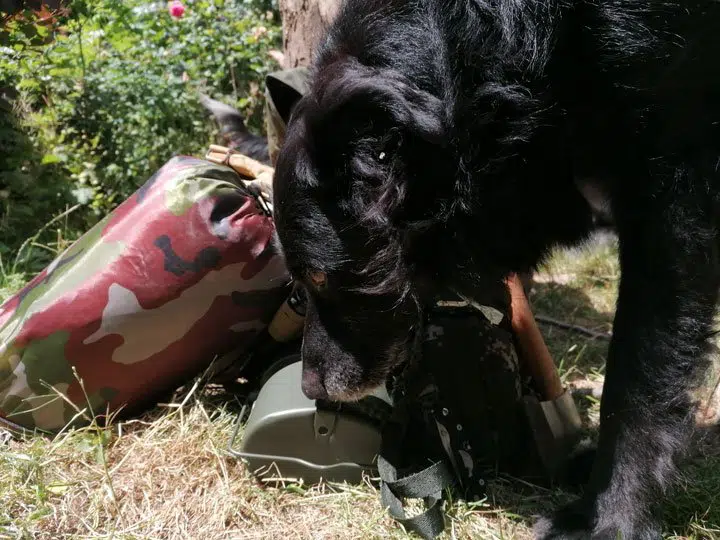Bonding with your dog outdoors is an incomparable experience from just taking them out on a walk. Going on a hike may be the perfect opportunity to take your dog along with you to take advantage of nature, time and open ground for exploration.
Although going on a hike with man’s best friend may seem ideal, there are several factors to consider for your pet’s wellbeing. In order to ensure your pet’s good health and comfort along with their enjoyment, take a look at the following key points that will help you have a successful trip for both of you.
Hiking: Is the trip for you or for your pet?
While humans are very goal-oriented when it comes to going on excursions, dogs don’t have that same sense of purpose. They are curious creatures that are eager to explore, experience new things through taste and smell and marking their territory.
Regardless if a dog is educated or not, it’s imperial that while going out on a hike with a dog, it is you who adapts and adjusts to your dog’s pace – although this may cause you to trip or fall once or twice!
Unless the trip is solely for the purpose of bonding with your dog and to provide an experience for your best friend, it’s best if you don’t take your pet on a trip with you. This is because your dog, like any other animal, will have needs that will need to be taken care of.
If you are concentrating on what you need to do to be comfortable and to accommodate for your own needs, your dog may not be getting the care and attention it deserves. Dogs love to please their masters and to be constant companies, and this love and care should be reciprocated.

No Dogs Allowed: Planning Your Trip
Before setting out to go on a trip with your pet, check in advance if the hiking trail you’ll be taking allows dogs. If you’re not sure where you want to go yet and want to check for dog-friendly trails, you can check out a great alltrails.com, which is a great source to tell you if you can take your pet along with you or not.
Be wary not to choose dangerous or difficult trails with rough or rocky terrains, which are not dog-friendly. Stay away from cliffs or drop-offs in case your dog wonders around and fails to see the danger in the terrain.
The first time you take your dog out on a hiking trip, you should stay close to home in case your dog doesn’t enjoy or adjust to the activities. A location near your home will be the perfect place to test the waters and see if your dog is ready for a bigger trip.
Is Your Dog Fit For The Trip?
Depending on the breed and size of your dog, your dog will be able to cover less distance traveling. One of the important factors to check is the amount of steps it takes for your dog to match one of yours.
To put it in contrast about why this is important, consider a Yorkie and a Great Dane. While both types of dogs may be very active, it would take a Yorkie a lot longer to walk the same distance as a Great Dane.
This is not only relevant to put into perspective to check how quickly your dog could tire, but also because as you are outdoors, you and your dog could come across other wildlife that could be dangerous to both you and your companion.
A factor that impacts a dog’s stamina that is commonly overlooked is how their cardiovascular system is compromised when a dog has breathing limitations.
Hot and cold weather can affect a dog’s ability to breath, which must be considered as dogs with a short snout are prone to poor heat management. To help in cases of hot weather, a cooling vest may help dogs with short snouts to help control their breathing better.
Factors such as the regular exercise that your dog does, its age and the fact that they are domesticated creatures could be what makes man’s best friend an asset or a setback during a trip.
Age: The Unstoppable Factor
Your dog’s age will most definitely influence their stamina to keep up during a hiking trip. As puppies are generally so hyper and full of energy, their eagerness may be misconstrued as stamina. However, puppies sprint and jump for short periods in which case a lot of stamina is not needed. Long hikes would require energy and stamina that a pup may not yet have built up.
Adolescent dogs and puppies cannot go through strenuous trails as their bones are still growing and are more fragile and prone to being broken, so it’s best to check with your vet before going on a hike with a young dog.
On the other side of the spectrum, older dogs are prone to suffering from arthritis or painful joints, and while it is still important to keep them moving, a long hike would not be recommended for them.
Just like for humans, diet has a major impact on the quality of life of a dog as it grows old. A dog with a natural diet would be less likely to need any supplements. Commercial dog food can have very loose regulations and if you love your four-legged friend, you should consider providing real raw food as part of your furry friend’s diet.
Domestic Dogs vs Wild Dogs
Canines are amongst the most versatile and adaptable predators on the planet. Although domestic dogs descend from these great hunters, today’s breeds couldn’t be further from their ancestors.
Like humans, dogs no longer have many skills to survive and behave in the wilderness, but with practice some “muscle memory” can wake up some lost instincts.
Improve Your Dog’s Stamina and Physical Fitness
A dog’s endurance has to be built up, which is why it’s so important to maintain an active lifestyle with your dog from a young age.
Taking your dog along with you while you go jogging may not be the best type of activity to build a dog’s stamina, as they love to stop and smell things around their environment constantly.
However, if your dog seems to enjoy going along with you on a jog, it would not be an issue to take him along. As a good exercise, you can take your dog to go on walks in the wilderness.

Helping Your Dog Adjust to Temperature
Dogs are adaptable creatures that can be trained to resist tough temperatures, however there are of course limits. Older dogs can regulate their body temperatures to help them adjust to the climate, but puppies are less efficient at doing so.
Training your dog to be accustomed to different temperatures takes some getting used to and should be done gradually.
Educate Your Dog to Sense Danger
As domesticated animals, dogs did not have the privilege to be born and grow up in the wild, which is what gives them the skills and experiences that a wild animal needs to survive. Because of this, a dog’s owner should act as a parent to take care of the dog’s needs.
Learning how dogs communicate should be a must for every dog owner, to help us understand our pet’s needs and approach towards danger and other things around their environment.
Protect your pet from danger, but also don’t be hyper-protective and let him learn his lessons.
Help Train Your Dog’s Behavior
From a young age, it’s important to teach a dog about human social rules and to learn to follow some basic instructions. The type of rules that a dog should learn are directly related to the size of the dog.
Big dogs that are uneducated and not accustomed to following certain behavior patterns brought on by training can easily break things or hurt someone, being outdoor chaos waiting to happen.
When a dog has been trained and educated properly, the dog should follow your lead promptly and avoid misbehaving. The key to educating any dog is positive reinforcement, consistent behavior and no violence.
Praising your dog when he has done something good is the key factor of positive reinforcement. However, even when a dog misbehaves there are ways of putting positive reinforcement into play, such as when your dog doesn’t follow instructions, in which case it’s best to ignore him as a reprimand.
Ignoring your pet must not be confused with isolation, as this is an offensive form of punishment towards your dog.
The most important aspect of educating your dog is consistency in your own behavior. One should avoid being violent or aggressive towards a dog, not only during training. Showing two different types of behavior for the same action would be inconsistent and confusing for the dog.
The best example for providing consistency in your behavior is when it comes to reprimanding a dog for jumping on you while you are well-dressed. If you were upset as this behavior took place, you cannot act pleased when a dog jumps on you while you’re wearing regular clothes.
In order for your dog to differentiate between acceptable and unacceptable behavior, it’s important to always keep the same attitude towards an action, regardless of the circumstances.
Strengthening a Pup’s Immune System
One of the physiological differences between wild animals and domestic ones is their immune system. Wild animals are strong because they survive in a tough environment, while dogs have a vaccine for everything from an early age, which protects them from common illnesses but also weakens them as they have no need to adapt to viruses.
Puppies can be introduced gradually to spending time outdoors once their vet has approved it.
Paw Patrol
A dog’s paws are not as strong as you may actually think; they can get blistered and damaged easily when a dog participates in activities that it doesn’t normally do.
Depending on the breed of the dog, their paw pads will have better resistance to certain environments, such as it happens with Newfoundland dogs, which have weaker paws compared to other breeds of dogs.
If you will be taking your dog on a hike with you regularly, it’s best to take them on walks in rough terrain progressively from a young age, so that they can build enough callus to resist a tougher type of environment.
Extreme weather conditions also play a role in how much a dog can withstand on their paws. Through their paw pads, dogs are able to control their body temperature, so it’s important to avoid extreme temperatures, which could cause paw damage and illness.
Paw Protections
To prevent your dog’s paw pads from cracking, it is recommended to apply a protective wax on the pads.
Avoid making a dog wear booties and any type of dog shoes, as dogs tend to never grow used to wearing them even over time. Since it is not natural for dogs to wear shoes, they are more prone to slipping and losing pad sensitivity over time.
However, if you do choose for your dog to wear protective shoes or booties, here as a video that can help you teach your dog to wear them:
Signs That Your Dog Is Unwell And How To Avoid It
In order to prevent illness or unwellness for both you and your dog, it is recommended to hike early in the morning or late in the evening to avoid sun peaks.
It’s important to check your dog’s paws often and feel their temperature to see how your dog is affected by the climate. If they feel cold, work on warming them up. If they feel too hot, it’s important to cool them down.
Exhaustion is something you must also check to ensure your dog’s well-being. Some of the symptoms of exhaustion include:
- Rapid panting
- Bright red tongue
- Pale gums
- Sticky thick saliva
- Weakness
- Vomiting
If you notice that your dog is experiencing any of these symptoms, do everything you can to ensure your dog’s temperature stays as cool as possible as quickly as you can. Placing a wet towel around your dog’s full body can help with the cool down process.
Addressing Your Dog’s Needs After Every Stop
Stopping to get some rest during a hike presents the perfect opportunity to check your dog’s
- Eyes
- Ears
- Paws
- Tail
- Armpits
- Mouth
Inspect your dog’s body orifices for the presence of wounds, mites, leaves, foreign objects or ticks. Some body parts can hide unwanted objects in their crevices and orifices, so it is always wise to check everything carefully.
If one of these objects crawls into an orifice, it will be difficult to remove it later on if it is not removed immediately. Some breeds are more prone to these types of intrusions due to the shape of their ears and other body parts.
Your Dog’s Packing Checklist
It is sometimes seen that a person may want to attach a backpack to a dog’s back, which raises the question if a dog can withstand the weight of a backpack. As it is a person’s choice and responsibility to choose the trail and its difficulty, as such it is not fair for your dog to carry weight on its shoulders.
It is okay for a human to carry a backpack as the weight is carried on the person’s hips, which is their center of gravity. As a dog’s anatomy is much more different to that of a human, a dog would not be able to carry the weight in the same way a person can.
Carrying a backpack could affect a dog’s balance and mobility, besides causing discomfort on the dog.
To be prepared to take your dog along with you on your hike, you can take the following things along with you:
- Treats
- Your dog’s favorite toy
- Your dog’s blanket
- A brush or a comb
- Medications (if your dog needs any)
- Dog first aid kit
- Vaccination card and documents from your vet
- Pet insurance details
- Poop bags
- Water
- Water bowl
- Whistle
- Dog food
- Leash and extra leash
- Towel
Especially if you’re still in the process of educating your dog, treats will be a welcome incentive for your dog. The best treats are homemade and can be made on a food dehydrator, where you can easily make tasty treats such as dehydrated liver stripes, which can be cut or broken into small pieces.
Objects that remind your dog of home such as small toys or a blanket can help to make him feel connected to something familiar.
A brush or comb will help you remove objects from your dog’s fur in case he gets into a messy environment.
In case there is a need to take your dog to the vet, it’s important to take your dog’s vaccination records and your dog’s medical booklet with you on the trip.
In order for a dog to stay hydrated, a dog needs to drink approximately every three miles. If you will be purchasing a new bowl for the trip consider it being BPA free, for your pet’s health.
A whistle should always be a part of your list of things you must take on your trip. The whistle can be used for two things: to call your dog if he is trained to respond to it and in case of emergency so you can call out for help.
Although kibble is practical to carry, it can be deemed unsafe and detrimental to your dog’s health. This is because pet food producers use nearly anything they want to, as long as it doesn’t kill your dog instantly.
According to Honey’s Real Dog Food, a raw dog food producer, the current law in most countries allows pet food producers to use nearly whatever they want as long as it doesn’t kill your dog instantly.
Instead of kibble or typical dog food, it is recommended to feed your dog raw food. Although many may seem this as unsafe for a dog, a dog’s stomach is strong enough to deal with nearly any bacteria thanks to the extremely high acidity found there.
Even though you would more than likely be traveling with a leash, consider taking an extra one in case the current leash gets lost or broken. Having an extra leash would be a valuable backup in these types of situations.
Last, but not least taking a towel with you would be optimal as it can be used for multiple situations. It can be used to dry your dog or to cool him down in case of heat stroke.
Tips

- Dog tags: make sure that your dog has a tag with your details, a rabies tag or a microchip with updated information.
- Water quality: if you will be giving your dog water collected from the wild, remember to purify the water that your dog will drink.
- Clean up after your dog: dogs with a raw food diet will produce good manure for the local vegetation, but if you are on a trail where other people walk, you should never leave traces.
- Dog GPS: if losing your dog is a concern, a dog GPS can help you to find your dog even if he wonders around.
- Attach a hand lamp to your dog: a lamp can be attached to your dog’s harness when it’s dark to see where your dog is. The best position for the lamp is in the chest area so that it doesn’t interfere with your dog’s vision.
- Never trust your dog: dogs have their own temper and personality and can choose when to listen or not listen to your instructions. To avoid accidents, keep a close eye on your dog and be sure to always keep him on a leash.
Trail Etiquette For Hikers With Dogs
While it’s important to pay attention to your dog, it’s also imperial to mind other hikers and their dogs during your trip. As you see other hikers coming your way step off the trail with your dog to let them pass and maintain good trail etiquette.
As explained on backpacking tips, pick up after your dog and yourself so that you can leave the environment in the same condition in which you found it. Ensure your presence in the wild does not cause a negative impact and enjoy the trip with your dog. This will be a bonding experience that you will never forget and that your pet will surely enjoy if you take due care.




